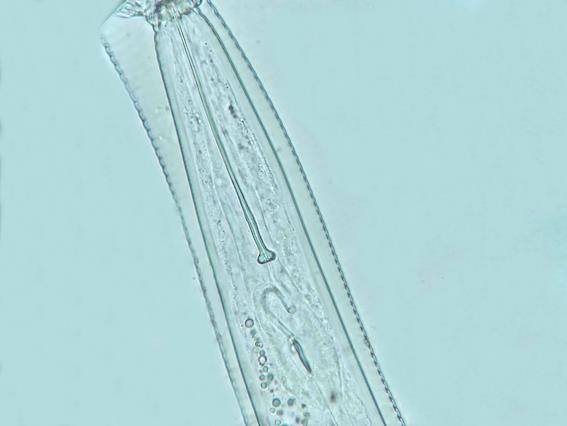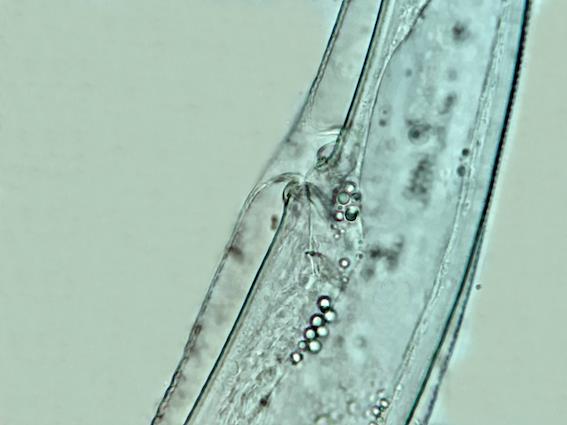Figure 1. Taxonomic details of Paratylenchus sp. found in peach rhizosphere.
Figure 2. Tail of Paratylenchus sp. found in peach rhizosphere.
Figure 3. Stylet of Paratylenchus sp. found in peach rhizosphere.
Figure 4. A specimen undergoing ecdysis, culminating in a female, of Paratylenchus sp. found in peach rhizosphere.
Figure 5. Vulva of Paratylenchus sp. found in peach rhizosphere.
Paratylenchus sp. é um dos menores nematoides parasita de plantas (0,18-0,60 mm de comprimento). Embora pequeno, esse nematoide possui um estilete bastante evidente que pode atingir camadas mais internas de células durante sua alimentação em raízes de plantas. Sendo ectoparasita migrador, pode-se tornar sedentário por um certo período durante sua vida. É comumente encontrado em rizosfera de plantas perenes. Um espécime em processo de ecdise, culminando em uma fêmea, é ilustrado (Figura 4). Paratylenchus sp. foi encontrado em baixa população (21 espécimes/100 cm3 de solo) em rizosfera de solo pessegueiro de pomar em Campestre da Serra, RS (Protocolo: 164017, junho 2020).
***************
Paratylenchus sp., pin nematode, is one of the smallest plant parasitic nematodes (0.18-0.60 mm long). Although small, this nematode has a very evident stylet that can reach the innermost layers of cells during its feeding on plant roots. Being a migrating ectoparasite, it can become sedentary for a certain period during his life. It is commonly found in the rhizosphere of perennials. A specimen undergoing ecdysis, culminating in a female, is illustrated (Figure 4). Paratylenchus sp. was found in a low population (21 specimens / 100 cm3 of soil) in rhizosphere of peach orchard soil in Campestre da Serra, RS (Protocol: 164017, June 2020).
The genus Paratylenchus was originally described with P. bukowinensis as the type species. There were 117 described species of Paratylenchus by 2016. Their identification has become increasingly difficult, mainly due to their similar morphology and the mall differences among many species (link).
Some species are known to be pathogenic to crops, including P. projectus , P. bukowinensis, P. neoamblycephalus, P. dianthus and P. hamatus so unambiguous and accurate identification of is necessary for designing effective management strategies and or distinguishing pathogenic from non-pathogenic species (link).
Referências:
Ghaderi, R., Kashi, L., Karegar, A. 2014. Contribuição para o estudo do gênero Paratylenchus Micoletzky, 1922 sensu lato (Nematoda: Tylenchulidae). Zootaxa 3841 (2): 151–187. Raski & Luc, 1987. Rev. Nematol. 10 (4): 409-444.
Mai, W.F., P.G. Mullin, H.H. Lyon, K. Loeffler. 1996. Plant-parasitic nematodes: A pictorial key to genera. Cornell University Press, Ithaca.
Santos, R. S. Nematoides associados a cinco fruteiras em Rondônia, RO. Revista de Agricultura v.91, n.1, p. 101 - 110, 2016. Disponível em: https://ainfo.cnptia.embrapa.br/digital/bitstream/item/142892/1/26012.pdf. Acesso em: 08 jul.2020.
Walters, S. A. ; Bond, J. P.; Russell, J. B.; Taylor, B. H.; Handoo, Z. A. Incidence and influence of plant-parasitic nematodes in Southern Illinois peach orchards. Nematropica Vol. 38, No. 1 (June 2008). Disponível em: https://journals.flvc.org/nematropica/article/view/64448. Acesso em: 08 jul.2020.
******
How to cite: Coutinho, R. R. Paratylenchus sp. in peach rhizosphere. Agriporticus. Disponível em: <http://www.agronomicabr.com.br/agriporticus/detalhe.aspx?id=912>. Acesso em: 08 jul.2020. (Atualize a data de acesso.).







